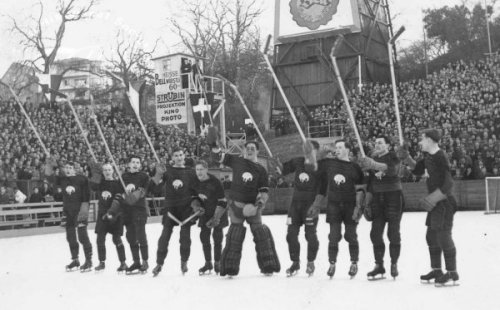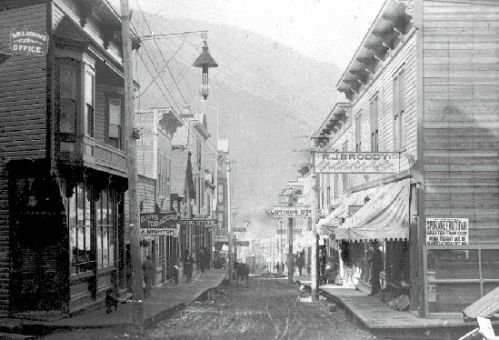by Ron Spence
The Stanley Cup was first awarded in 1893 to a Montreal team. That same year an arena was built in the Kootenays. It was in the town of Sandon, and a year later the Crystal Ice Palace was constructed in Nelson. The Palace held 2,300 spectators and was the largest rink west of Winnipeg.
At the turn of the century, Nelson, Rossland, Greenwood and Grand Forks competed with other rivals from the former towns of Sandon, Phoenix and Moyie.
Like the International Hockey League in southern Ontario and Northern Michigan several years later, this circuit was supported by a flourishing mining industry. Players were imported from the prairies and the Kootenay hockey was top calibre.
Kootenay hockey during this era was in contrast to the fun hockey in the north Okanagan centre of Salmon Arm, where games were played on the McGuire and Shuswap Lakes.
When Frank and Lester Patrick arrived from Quebec in 1908, they helped to build a larger open ice arena. Their Nelson team beat all of B.C.’s squads, but lost to the Alberta champions from Edmonton.
One future Hall of Famer who came from the Kootenays – at this time – was Cecil “Tiny” Thompson. He was born in Sandon in 1905 and would win four Vezina Trophies.
B.C.’s first professional players also hailed from the Kootenays. Sid Desireau and Frank Ogenski of Nelson played in the Patrick’s Coast league.
Kootenay hockey grew in popularity and a few years after World War 1, Kimberley, Cranbrook, Chapman Camp, and the logging centre of Wycliffe formed a league. Kimberley had built their rink four years before, and Cranbrook hosted their home games on a local pond.
Three senior teams from Trail, Rossland and Nelson registered with the B.C. Amateur Hockey Association for the 1922-23 season. Intermediate teams from Trail and Nelson did the same, and played Okanagan teams from Salmon Arm and Enderby.
Senior hockey flourished and two senior circuits were created the following season. The East Kootenay League consisted of Lumberton, Wycliffe, Fernie, Cranbrook and Kimberley. The West Kootenay teams were Nelson, Grand Forks and two teams each from Trail and Rossland.
A Kootenay team competed for the B.C. championship the 1922-23 season, and after a defeat, won the Savage Cup two years in a row.
The 1925-26 season the Trail arena installed artificial ice, which made it the Kootenay’s first covered rink. Trail won the Savage Cup for the next seven seasons, and the Kimberley Dynamiters won the Coy Cup as the province’s Intermediate Champions.
Kimberly also joined the Seniors’ competition the 1931-32 season and “imported some excellent players.” They won the B.C. senior championship the 1933-34 season, and the following two years. Then while the Dynamiters were traveling in Europe, Nelson won the Savage Cup the 1936-37 season.
Alberta teams from Lethbridge and Coleman joined the Kootenay Senior League the following year, and it was renamed the A.B.C. League. Trail won the Savage Cup and went on to defeat the Cornwall Flyers for the Allan Cup. The next season Kimberley won the Savage Cup again, while Trail was taking the World Cup in Europe.

THE SMOKIES WIN - 1939 - courtesy of http://www.trailsmokeaters.com
Trail and Kimberly shared the Savage Cup the next three seasons, prior to the War and then coast teams took the title while the Kootenay rosters were depleted.
The 1946-47 season, the old Kootenay Senior League expanded to include Spokane (Spartans) and Los Angeles (Ramblers) teams. It was called the Western International Hockey League, and actress Dinah Shore and actor George Montgomery donated a trophy.
Los Angeles lasted one season, while Spokane played for most of four decades – the league lasted until 1986-87.
Trail won a number of the Savage Cups, until Okanagan teams started to dominate in 1953. Penticton won the Cup twice, Kelowna once and Vernon three times. The Vees were good enough to win the World Cup, and Vernon, the Allan Cup once.
By 1960, things had returned to normal and W.I.H.L. teams won the Savage Cup twenty-three years in a row. Spokane cleaned up during the decade after 1968. They won eight Savage Cups in ten years, and three Allan Cups in five years.
The Washington city had the advantage of a 5,000 seat arena, and a healthy budget.
Still, the other major Kootenay teams did nearly as well. Trail won the Savage Cup four times, Nelson six, Kimberly three and Cranbrook twice from 1960 until the late ’80s. Trail, Kimberly and Cranbrook also won Allan Cups during this period. Other Kootenay teams that came and left, were Rossland and Elk Valley, which won the Savage Cup in 1988.
By the mid-eighties the Kootenay seniors were attracting only five hundred fans. People were watching live junior games, and NHL contests on television, instead of senior hockey.
The Kootenay Junior B Hockey League had started the 1969-70 season, with teams in Trail, Rossland, Grand Forks, Nelson and Castlegar. These west Kootenay teams were joined three years later by a Spokane, and two East Kootenay teams. Later, Invermere and Creston also joined.
Kootenay teams no longer dominate B.C. hockey, but their new Major Junior team has been doing well. On June 17, 1998, the Western Hockey League’s Edmonton Ice relocated to Cranbrook.
To showcase the Kootenay Ice, the new 4,250 seat Cranbrook Recreational Complex – called the RecPlex – was built. The Ice won the Western Hockey League Championship, and played for the Memorial Cup in 2000, and won the Cup in 2002.
The game might have been played in eastern Canada, but spirit of Sandon was there 110 years later.
***************************************************************************************************************
The preceding article was written for the BC Hockey Hall of Fame.

